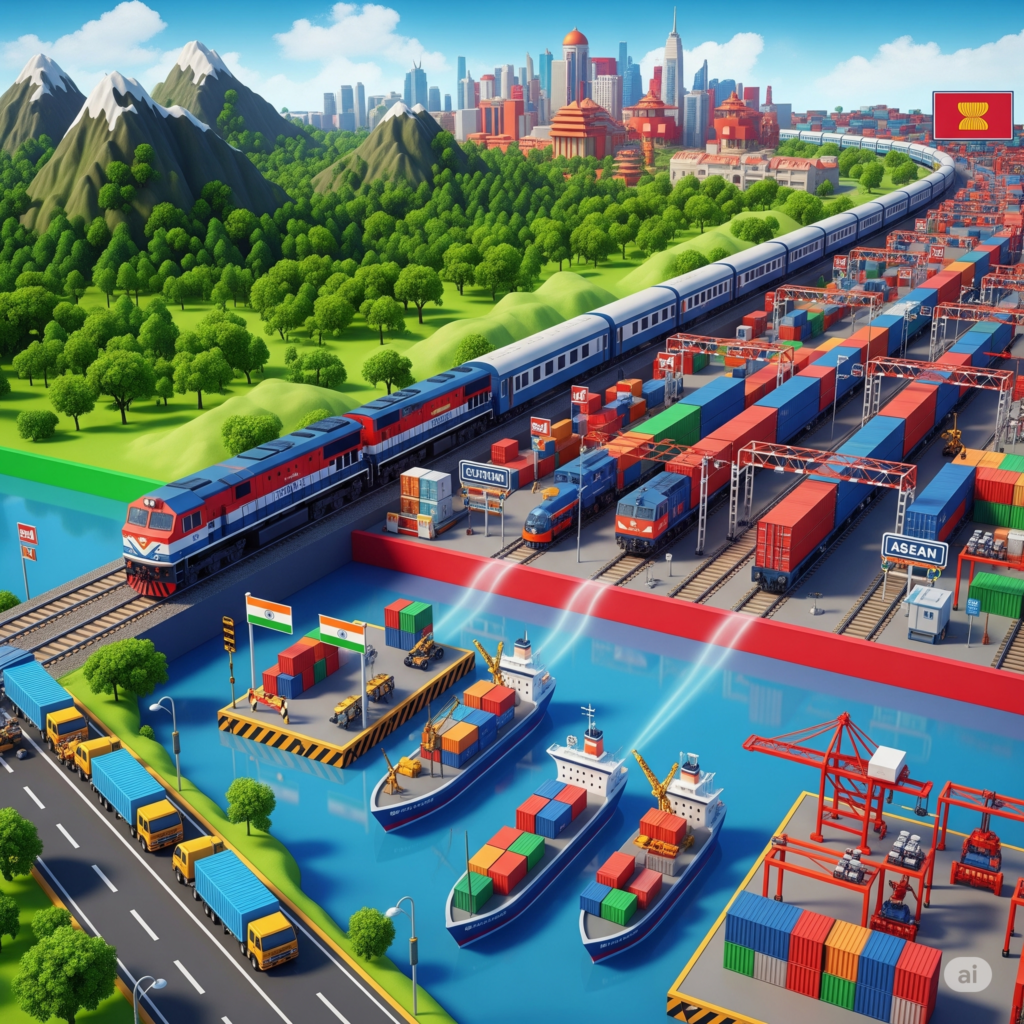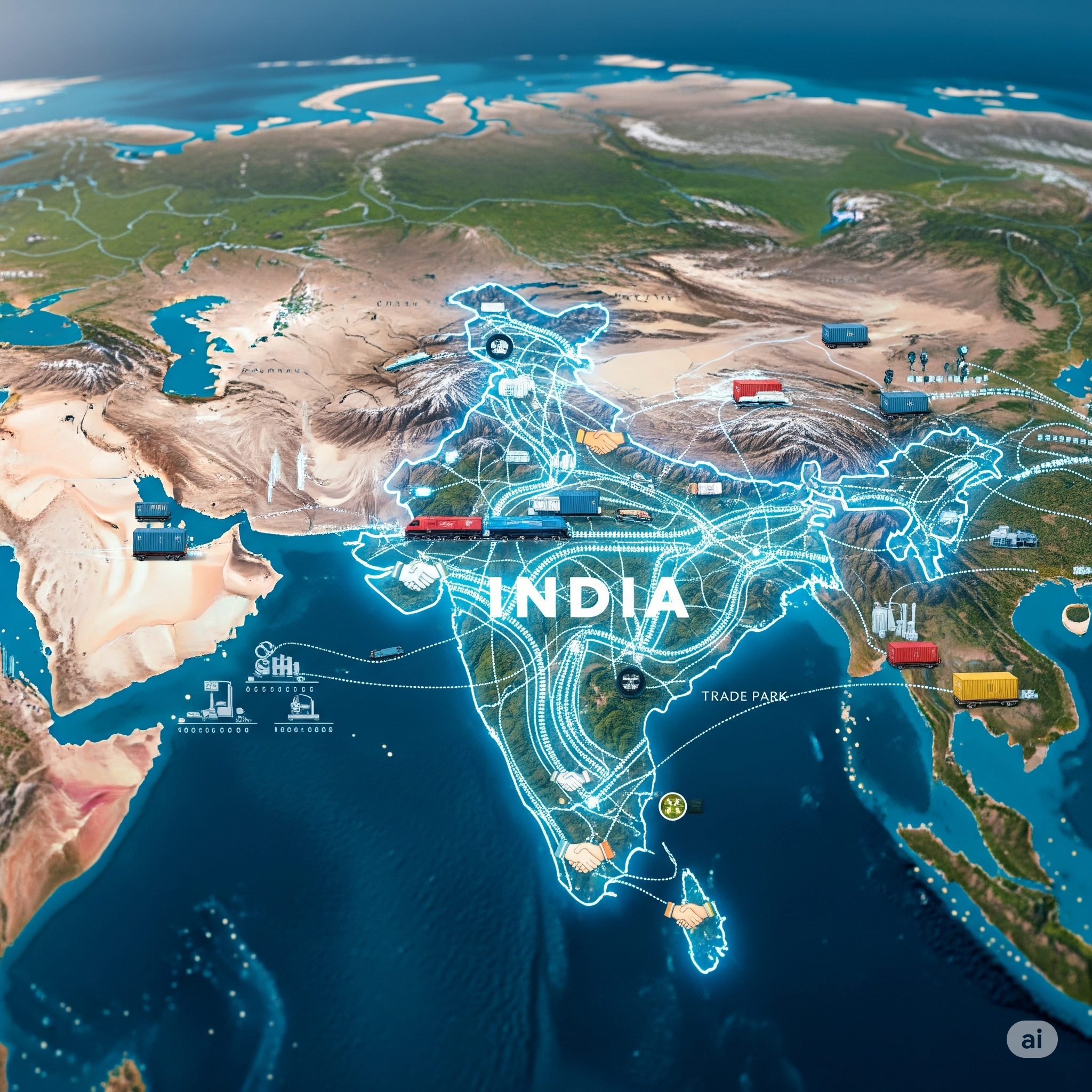📦 Quick Summary:
- India’s railway diplomacy has focused more on geopolitical strategy than maximizing economic returns.
- Cross-border rail links serve as tools for regional influence, especially in South Asia and Southeast Asia.
- Freight corridors, port connectivity, and inland logistics remain underleveraged for trade competitiveness.
- India must integrate railways into a multimodal, commercially viable connectivity model to unlock full potential.
- A shift from geostrategy to geo-economics is crucial for future transport diplomacy.
🚄Railways at the Crossroads of Strategy and Economy
India’s railway network—one of the largest in the world—has evolved beyond domestic mobility into a strategic tool of foreign policy. Over the past decade, key investments in cross-border rail links and regional transport corridors have served geostrategic objectives, aimed at countering Chinese influence, asserting regional leadership, and securing energy and trade routes.
However, the economic utility of these initiatives often remains under-optimized. Despite the transformative power of rail-based logistics, India’s strategy has leaned more toward security-driven motives than toward building sustainable economic corridors.
This essay examines how India can recalibrate its railway connectivity strategy to balance strategic compulsions with commercial viability.
🧭 The Geostrategic Imperative Behind Railway Diplomacy
1. 🇧🇩 India–Bangladesh Connectivity
- Revival of pre-Partition routes like Kolkata–Khulna, Agartala–Akhaura
- Supports India’s ‘Act East’ and ‘Neighbourhood First’ policies
- Helps bypass the Siliguri Corridor (‘Chicken’s Neck’), ensuring military and trade mobility
2. 🇳🇵 India–Nepal Rail Projects
- Jayanagar–Kurtha rail line and proposed links to Kathmandu
- Counters China’s BRI expansion into Nepal
- Enhances soft power and people-to-people ties
3. 🇲🇲 India–Myanmar–Thailand Trilateral Highway (with rail link extensions)
- Meant to integrate Northeast India with ASEAN markets
- Rail has been secondary, underfunded in comparison to road projects
- Faces delays due to terrain, insurgency, and diplomatic bottlenecks
4. 🚢 Strategic Freight Corridors
- Dedicated Freight Corridors (DFC) like the Eastern and Western DFCs
- Facilitate military logistics, especially near borders
- Yet to significantly reduce logistics cost (14% of GDP vs. 8% global average)
📉 Underutilized Economic Potential
While strategic rail lines are being built, several critical trade-oriented corridors remain underdeveloped:
A. Poor Rail-Port Integration
- Major ports like Mumbai, Chennai, and Visakhapatnam lack seamless freight rail corridors
- Results in cargo congestion, increased turnaround time, and higher costs
B. Lack of Multimodal Hubs
- India’s railways are not well-connected with inland waterways, industrial zones, or air cargo terminals
- No major logistics clusters akin to Rotterdam or Shanghai port-rail systems
C. Neglected Private Sector Participation
- Limited PPP (Public-Private Partnerships) in rail logistics
- Inadequate incentives for rail-linked warehousing, cold chains, and container services
📊 Data Snapshot: India’s Railway Metrics
| Parameter | India | Global Benchmark |
|---|---|---|
| Rail Logistics Cost (as % of GDP) | ~14% | ~8–9% |
| Average Freight Train Speed | ~25 km/h | ~60+ km/h (China, EU) |
| Rail Share in Freight Transport | ~27% | ~50% (China) |
| DFC Operational Coverage | <4,000 km | China’s HSR Freight: >20,000 km |
🛤️ What Needs to Change?

India’s rail strategy should transition from geo-strategy to geo-economics:
1. Multimodal Integration
- Connect rail with airports, dry ports, highways, and river terminals
- Create transshipment hubs at border points and SEZs
2. Commercialization of Railway Diplomacy
- Use international rail projects to boost exports, especially to ASEAN and Africa
- Leverage projects like Chabahar–Zahedan rail line (Iran) for Central Asia outreach
3. Digital and Smart Rail Infrastructure
- Expand use of RFID, IoT, and AI in freight management
- Predictive maintenance, smart scheduling, and e-logistics platforms are needed
4. Public-Private Ecosystem
- Encourage logistics startups and warehousing firms to co-locate near freight rail stations
- Allow private freight operators and reduce rail freight tariffs
🌏 International Best Practices to Learn From
- China’s Belt and Road Initiative (BRI) integrates rail with economic zones, inland ports, and energy corridors
- European TEN-T Network uses rail for internal trade harmonization and modal shift
- Japan’s Shinkansen freight adaptation is pioneering high-speed cargo delivery in aging societies
India must localize global models, with attention to terrain, political federalism, and environmental impact.
🔚 Conclusion: The Tracks Ahead
India has invested in railways with strong geopolitical foresight, particularly in countering China’s Belt and Road Initiative and strengthening its South Asian leadership. However, without a parallel economic vision, these rail corridors may remain strategic but underperforming assets.
For India to fully unlock the potential of its railways, it must pivot from strategic presence to strategic productivity—where rail not only connects borders but drives economic growth, export competitiveness, and industrial transformation.









+ There are no comments
Add yours